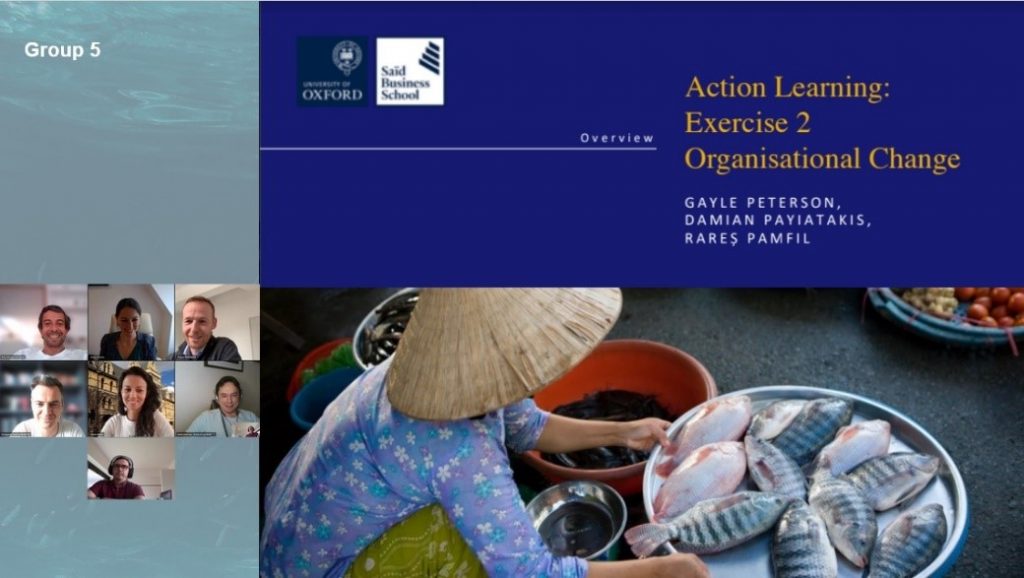Part Three of Learning by Philippe Mores, Luxembourg Ministry of Foreign and European Affairs
During Week 5, the class engaged in an open discussion with navigators and enablers who shared experiences from their everyday work on the ground. In doing so, the Course provided opportunities to allow for lasting connections among students and actors who engage in the field besides the more academic learning exercise.
M. Daniel Izzo, Executive Director at Vox Capital, shared his experience and underlined that it requires a lot of resilience and candour in Impact Investing, the most important lesson being not to lose sight of the final objective that one wants to achieve. At the outset, he provided an overview of his engagement in Impact Investing in emerging economies and his perspectives from Brazil. With a total of roughly 785 million USD assets under management and some 34 investors in Brazil (2019), Vox Capital invests in technology-based companies through equity and believes in investments that match financial returns with a social impact and with a special focus on the low-income classes. Although Vox Capital looks for companies with transversal solutions covering several layers of the population, it is necessary to proactively focus on the base of the socio-economic pyramid with affordable and high-quality products and services. In doing so, Vox Capital looks for high potential companies fitting into their main criteria: (i) an authentic and resilient enterprising team, with high performance capacity and great dreams, (ii) a business profile aligned with Vox’ investment profile and (iii) strategic economic sectors, with a large development potential for the Brazilian population. I thought he made a particularly interesting point about the paradox of competition and cooperation among Impact Investing actors. He also provided an overview of the Brazilian market in comparison to the world’s overall figures with regard to expectations on risk adjusted market returns and capital preservation.
M. Izzo briefly touched upon Vox Capital’s 2020-2025 recommendations for Brazil’s new national strategy for Impact Investing, which underwent an open consultation process. Five priority themes emerged from these discussions: (i) fostering local ecosystems, (ii) nourishing ecosystem enablers, (iii) the need for a special lens for low-income areas, (iv) impact accounting and (v) impact portfolios.

The second part of his presentation focused more on his day-to-day business in fund management and funding the right investment opportunities through the right criteria to assess companies. A large liquid market is obviously more favourable as it makes entries as well as exists easier.
In addition, Ms. Taís Silveira presented her successful investment case of Sanar – Education for Healthcare Professionals, a start-up from 2014. Sanar seeks to empower doctors with most accessible products in the market, to create healthcare communities for professionals and to accompany doctors on their entire journey starting with education (her project has been supported by Vox Capital in two rounds of financing). In 2019 and 2020, revenues as well as impact outputs (i.e. active students reached, students financed and credits allowed, among others) have truly skyrocketed. The class was divided up in smaller groups to debate real life dilemmas such as how to take this project forward, whether to increase exposition at the current round or to realize the gains (partially and fully) and why. Would you approve an investment if the proposed solution had a clear impact but the entrepreneurs were not necessarily committed to that impact? What if, once the company is already on your equity portfolio, you realize it is performing well financially, but it is not delivering the intended impact? The different arguments were considered with both Daniel and Taís and Vox Capital is still to decide how to actually take this project forward.
Personal reading suggestions (out of many others):
The second session of Week 5 provided the opportunity for students to ask questions in order to “get what they need” from the Course. To set the scene, Ms. Jenn Pryce, President and CEO of Calvert Impact Capital, provided a recap on some of the lessons learnt over the past weeks and presented further information on the landscape of key impact and ESG industry standards. Transparency and accountability are the main barriers to sustainable investments, especially in overlooks markets. The goal is to have information, data and a common set of standards and tools to help investors and advisors set, measure, report on and improve their various ESG and impact management practices.
To do so, Ms. Pryce sought to clarify the confusion with the variety of ESG and Impact Investing standards and tools that exist in different areas and at different levels. I found her insights especially useful and well presented as she went into the details of a myriad of standards and standard setters such as the GIIN, Aeris, GSG, HIPSO, IFC, the SDGs, PRI, IRIS+, the World Benchmarking Alliance, the Operating Principles for Impact Management to name just a few. Investors and advisors alike should identify their goals and strategy before determining which standards to use and there is a difference between “ESG Investing” (maximize financial performance), which is more common in public markets and “Impact Investing” (optimize financial and impact performance, balanced depending on investor strategy), more commonly found in private markets. Overall, they can be categorized into Frameworks (to define goals), Libraries (to align on metrics and definitions), Aggregators (distilling and reporting) and Evaluators (measuring progress), aside the more general industry supporters. Yet, non-standard reports are still important to go beyond specific examples and analyses.
The questions to “get what you need” could be sent in beforehand or were asked during the class. At least 18 very diverse questions were asked such as: Tainted money vs. taint never enough; How to fund smaller ticket projects at the seed stage, are there other models to scale? ; How do we reconcile negative effects of scale? ; What are common pitfalls/challenges to keep in mind for due diligence before, during and after monitoring investment? ; What are the fee structures for Impact Investment Funds that incentivize both financial and impact return? ; What are the costs involved in serving the “missing middle” in certain sectors and how this can be mitigated to increase the flow of capital? I asked to get more insights into the legal side of Impact Investing. What are the main regulatory frameworks/acts used for example in the UK or elsewhere in this field? What have other countries that are especially active in Impact Investing done in this field and can they be compared? What are the different fund structures that exist globally for different purposes in Impact Investing? Are you aware of any legal analyses of different fund structures?
The discussions and answers were obviously very diverse but some major take-aways included debates on the analysis of different regulatory or political risks, as well as the importance of an exit strategy (and how to get money out of certain countries).

The current and final Week 6 focused on technology and innovation with Associate Fellow Ms. Aunnie Patton Power (who presented her brand new book “Adventure Finance: How to Create a Funding Journey That Blends Profit and Purpose”) to understand the relevance of emerging technologies such as artificial intelligence, remote sensing and distributed ledger technology for Impact Investing. She proposed suggestions and answers to create a framework to assess technology enabled impact investments. The session also touched upon the function of platforms, smart contracts and automation in Impact Investing capital allocation.
The required pre-work for the session included a concrete example of a micro crop insurance (Rose Goslinga’s project in Kenya), as well as reading material on the technological component in ending poverty and additional information on blockchain. Technology can have a huge impact, especially on agriculture, which remains the largest sector in Sub-Saharan Africa.
From the outset, Ms. Aunnie Patton Power allowed for an honest and open discussion with the students. With regard to the application of technology, it is worthwhile to highlight not to reinvent the wheel and invest into expensive, new structures as many actors in the field are working or have worked on similar solutions. Very often, existing structures and protocols exit already and can be re-modelled to match individual solutions. There is a true graveyard of existing platforms out there, which have unfortunately not materialized in success. Local know-how and expertise is more abundant then one might be aware of, even in the more vulnerable, developing countries.
The class divided into a set of smaller groups to discuss and assess the example of the micro crop insurance against the 4A framework (Agency, Ambivalence, Amplification and Appropriateness). This led once again to interesting and sometimes controversial discussions, which can go far beyond the Impact Investing spectrum and which concern all of us i.e. data sharing, data ownership, vulnerabilities and market potential vs. technological progress.
Personal reading suggestions (out of many others):
The last Day of the Course was dedicated to the presentations of the group exercises that have been prepared throughout the duration of the Programme by the permanently created groups. Our group had to develop the case of a Head of Sustainable Investing at a European Private Bank to develop a strategy and a concrete plan to mobilise £100m to get the bank involved in SDG14 investing. We presented our vision and our story and explained how we would structure such a proposal. An important part of the exercise focused on how to engage and convince the internal departments and stakeholders (such as client relationship managers, product teams, leadership, compliance and marketing) to provide for organizational change but also through external partners. In doing so, you need to build a coalition of support and navigate a complex organisational structure to achieve your goal. It has been an intense but very useful exercise. I would like to thank my colleagues Natalia, Vanessa, Andrei, Jost, Pawel and Pedro for the most valuable exchanges and discussions.

This final session marked the end of the Programme, which, despite its extension over a couple of weeks, ended far too quickly! Even though the whole Programme has been conducted in an all-virtual environment, the excellent set-up managed to spark real interactions and to create personal connections with highly professional and outstanding people.
This ends my journey at Saïd Business School, University of Oxford and the Impact Investing Programme. I highly recommend the Oxford Impact Investing Programme to anyone wanting to broaden their understanding of Impact Investing and meet an incredible variety of passionate people working in this field. Do not hesitate to get in touch if you have any questions or would like to have more information on the Programme.
A special thank you goes to the Oxford University Programme Directors, Professors, Teachers and Experts:
Gayle Peterson, Alex Nicholls, Peter Hinton, Jenn Pryce, Aunnie Patton Power, Damian Payiatakis, Rareș Pamfil, Karim Harji and all other lecturers.
A big thank you also goes to the Oxford Programme Team:
Annabelle Richards, Abbi Churchill, Laila Valterio, Louisa Muller
Finally yet importantly, I would like to sincerely thank InFiNe.lu and the Ministry of Foreign and European Affairs of Luxembourg for this great opportunity!
If you want to know about Weeks 1 & 2 click here and for Weeks 3 & 4 click here.
Author: Philippe Mores
InFiNe is the Luxembourg platform that brings together public, private and civil society actors involved in inclusive finance. The value of InFiNe lies in the wide range of expertise characterised by the diversity of its members.
With the support of

Inclusive Finance Network Luxembourg
39, rue Glesener
L-1631 Luxembourg
G.-D. de Luxembourg
Tel: +352 28 37 15 09
contact@infine.lu
R.C.S. : F 9956
Legal notice
Privacy notice
Picture 1 © Pallab Seth
